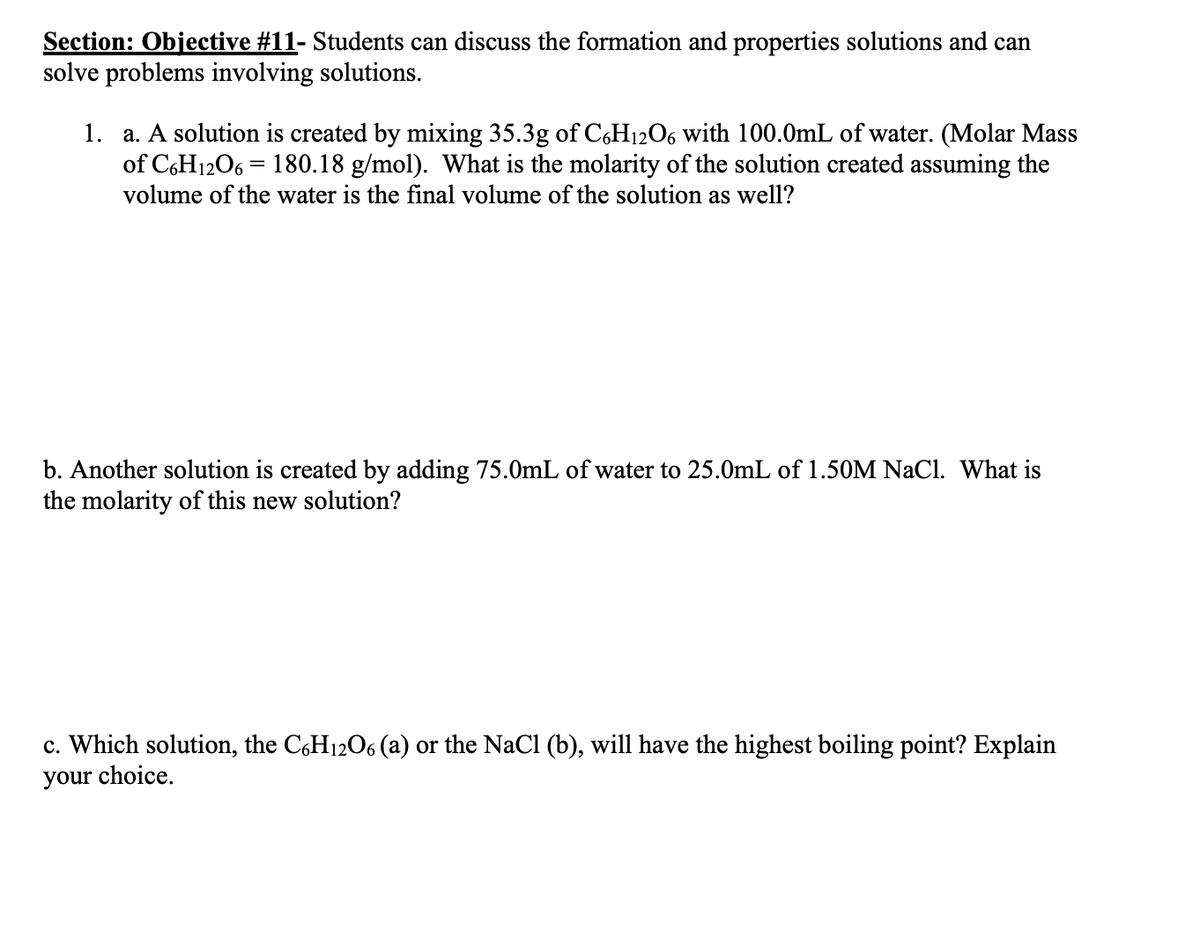1. a. A solution is created by mixing 35.3g of C,H12O6 with 100.0mL of water. (Molar Mas: of C,H1206 = 180.18 g/mol). What is the molarity of the solution created assuming the volume of the water is the final volume of the solution as well? b. Another solution is created by adding 75.0mL of water to 25.0mL of 1.50M NaCl. What is the molarity of this new solution? c. Which solution, the C,H12O6 (a) or the NaCl (b), will have the highest boiling point? Explain your choice.
1. a. A solution is created by mixing 35.3g of C,H12O6 with 100.0mL of water. (Molar Mas: of C,H1206 = 180.18 g/mol). What is the molarity of the solution created assuming the volume of the water is the final volume of the solution as well? b. Another solution is created by adding 75.0mL of water to 25.0mL of 1.50M NaCl. What is the molarity of this new solution? c. Which solution, the C,H12O6 (a) or the NaCl (b), will have the highest boiling point? Explain your choice.
Introduction to Chemical Engineering Thermodynamics
8th Edition
ISBN:9781259696527
Author:J.M. Smith Termodinamica en ingenieria quimica, Hendrick C Van Ness, Michael Abbott, Mark Swihart
Publisher:J.M. Smith Termodinamica en ingenieria quimica, Hendrick C Van Ness, Michael Abbott, Mark Swihart
Chapter1: Introduction
Section: Chapter Questions
Problem 1.1P
Related questions
Question
please help with part C)
show work

Transcribed Image Text:Section: Objective #11- Students can discuss the formation and properties solutions and can
solve problems involving solutions.
1. a. A solution is created by mixing 35.3g of C,H12O6 with 100.0mL of water. (Molar Mass
of C6H1206 = 180.18 g/mol). What is the molarity of the solution created assuming the
volume of the water is the final volume of the solution as well?
b. Another solution is created by adding 75.0mL of water to 25.0mL of 1.50M NaCl. What is
the molarity of this new solution?
c. Which solution, the C,H12O6 (a) or the NaCl (b), will have the highest boiling point? Explain
your choice.
Expert Solution
Step 1
Given data:
Mass of C6H12O6 = 35.3 g
Volume of water = 100 mL
Molar mass of C6H12O6 = 180.18g/mol
Step 2
(a)
The molarity of the solution is calculated as follows:
It is given that the volume of water is assumed to be the final volume of the solution.
Number of moles of C6H12O6 is,
Molarity is the ratio number of moles of the solute to the volume of solution in L.
It is represented by M.
............... (1)
Step 3
Plugin the values in equation (1)
Step by step
Solved in 5 steps

Knowledge Booster
Learn more about
Need a deep-dive on the concept behind this application? Look no further. Learn more about this topic, chemical-engineering and related others by exploring similar questions and additional content below.Recommended textbooks for you

Introduction to Chemical Engineering Thermodynami…
Chemical Engineering
ISBN:
9781259696527
Author:
J.M. Smith Termodinamica en ingenieria quimica, Hendrick C Van Ness, Michael Abbott, Mark Swihart
Publisher:
McGraw-Hill Education

Elementary Principles of Chemical Processes, Bind…
Chemical Engineering
ISBN:
9781118431221
Author:
Richard M. Felder, Ronald W. Rousseau, Lisa G. Bullard
Publisher:
WILEY

Elements of Chemical Reaction Engineering (5th Ed…
Chemical Engineering
ISBN:
9780133887518
Author:
H. Scott Fogler
Publisher:
Prentice Hall

Introduction to Chemical Engineering Thermodynami…
Chemical Engineering
ISBN:
9781259696527
Author:
J.M. Smith Termodinamica en ingenieria quimica, Hendrick C Van Ness, Michael Abbott, Mark Swihart
Publisher:
McGraw-Hill Education

Elementary Principles of Chemical Processes, Bind…
Chemical Engineering
ISBN:
9781118431221
Author:
Richard M. Felder, Ronald W. Rousseau, Lisa G. Bullard
Publisher:
WILEY

Elements of Chemical Reaction Engineering (5th Ed…
Chemical Engineering
ISBN:
9780133887518
Author:
H. Scott Fogler
Publisher:
Prentice Hall


Industrial Plastics: Theory and Applications
Chemical Engineering
ISBN:
9781285061238
Author:
Lokensgard, Erik
Publisher:
Delmar Cengage Learning

Unit Operations of Chemical Engineering
Chemical Engineering
ISBN:
9780072848236
Author:
Warren McCabe, Julian C. Smith, Peter Harriott
Publisher:
McGraw-Hill Companies, The